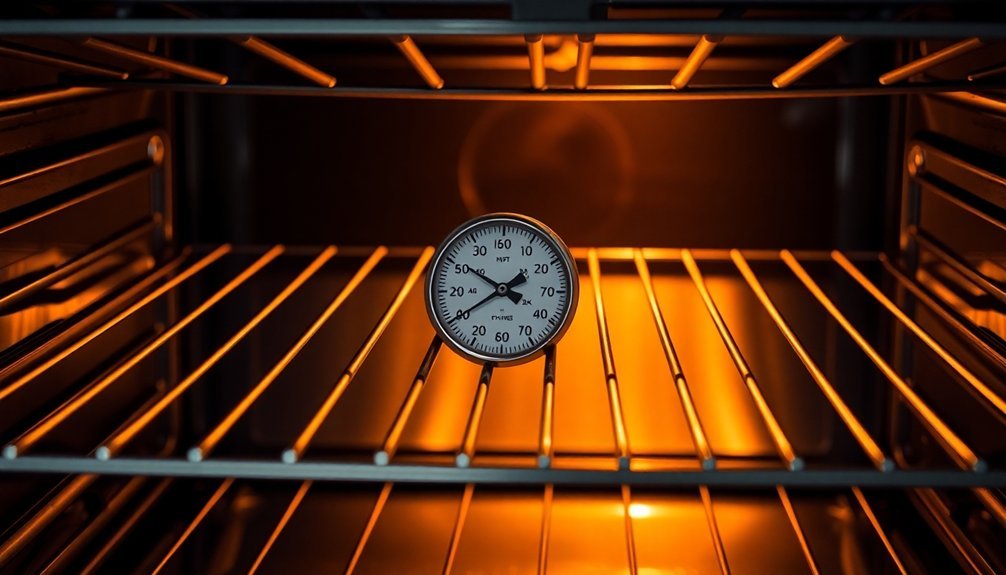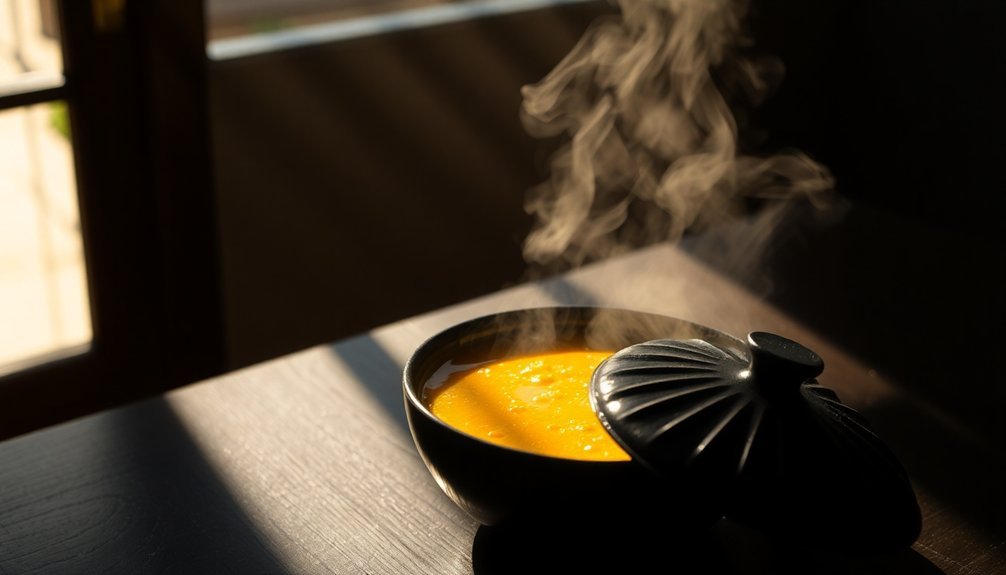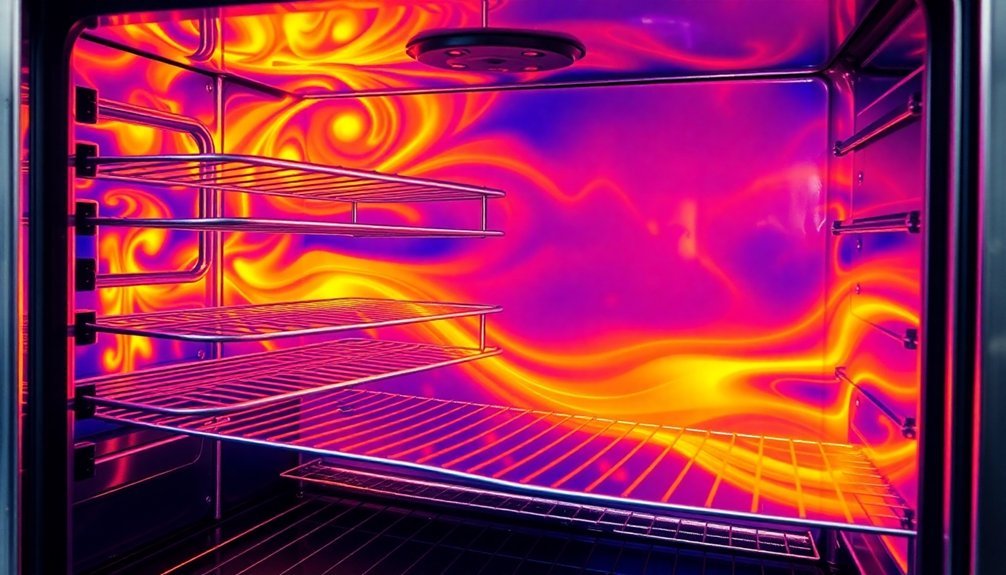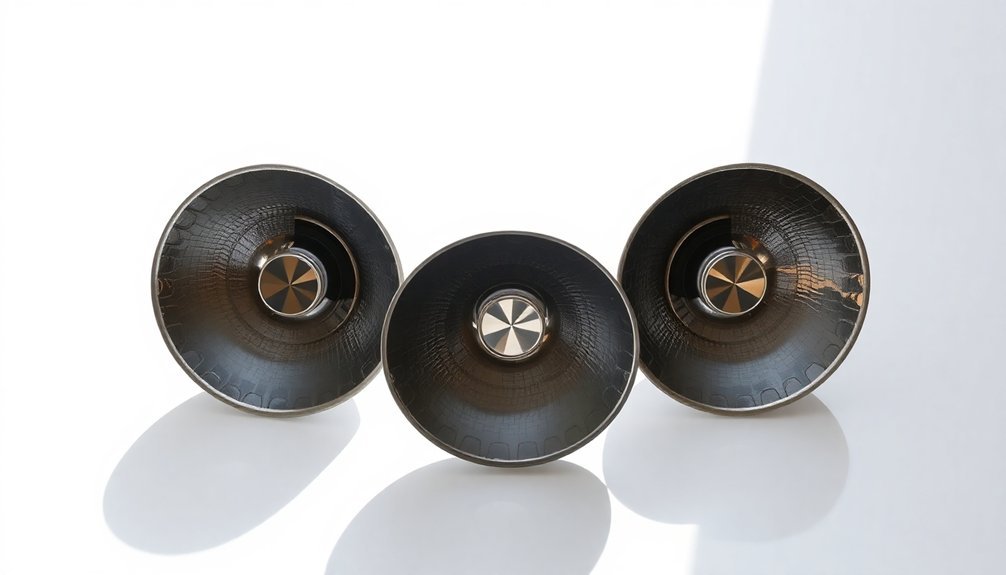Testing your oven's true temperature is essential for perfect baking results since built-in thermometers can be off by up to 50°F. You'll need a reliable oven thermometer placed in the center of the middle rack at 350°F to start your test. Let your oven complete 2-3 heating cycles before taking readings, and keep the door closed to maintain stability. Check for hot spots by arranging white bread slices in a grid pattern across your rack – uneven browning reveals temperature variations. The middle rack typically provides the most even cooking environment, but understanding your oven's unique heating patterns will transform your culinary outcomes.
Why Temperature Testing Matters

Although your oven's temperature dial might seem trustworthy, it could be deceiving you every time you cook. Your oven's actual temperature can vary by up to 90 degrees from its setting, and even built-in thermometers can be off by 50 degrees. Ovens typically maintain temperatures through heating cycles on and off.
This matters because temperature accuracy directly affects your cooking results. When you're baking at what you think is 325°F, but your oven's actually running at 360°F, you'll likely end up with overcooked edges and undercooked centers.
Your cakes might dome unexpectedly, cookies could remain raw inside, and bread might brown unevenly.
Following recipe instructions becomes impossible when your oven's temperature isn't accurate. Since each dish requires specific heat for ideal results, knowing your oven's true temperature helps you achieve the perfect outcome every time.
Gathering Essential Testing Equipment
To properly test your oven's temperature, you'll need to assemble the right tools first. Start with a reliable oven thermometer, as it's the foundation of accurate testing.
You'll also want heat-resistant gloves and baking sheets for safe handling during the process.
For thorough testing, make sure you have:
- An NIST traceable or digital thermometer to verify temperature accuracy
- White bread slices for checking hot spots and heat distribution
- A timer to track precise heating durations
- A notebook or camera to document your results
Don't forget to gather secondary verification tools like an infrared thermometer for quick spot checks.
Annual professional calibration will ensure your testing efforts lead to consistently reliable results over time.
If you're planning extensive testing, consider adding a pizza stone to help distribute heat more evenly throughout your oven's cavity.
Basic Oven Temperature Check

Performing a basic oven temperature check starts with proper thermometer placement and consistent monitoring.
Position your thermometer in the center of the middle rack, ensuring it's the only item in your oven during testing. Using a cast iron pan as a base for your thermometer provides the most reliable temperature readings.
Set your oven to an easily readable temperature, like 350°F, and let it complete at least two or three heating cycles before taking readings.
Keep the door closed throughout the process to maintain temperature stability.
You'll notice your oven's temperature naturally oscillates as it cycles on and off – this is normal.
Compare the thermometer reading to your set temperature; it should be within 10-30 degrees of your target.
If you spot significant differences, you'll need to either adjust your oven's calibration settings or modify your recipe temperatures to compensate for the variance.
Common Temperature Testing Mistakes
When testing your oven's temperature, you'll want to avoid several common mistakes that can lead to inaccurate readings. Many home bakers skip essential steps in the testing process, compromising their results and affecting their cooking outcomes.
- Not properly calibrating your thermometer using both ice bath and boiling water tests while accounting for altitude variations.
- Placing the thermometer incorrectly by failing to secure it at the center of the rack or opening the door during testing.
- Rushing the testing process by not allowing sufficient time for temperature stabilization or failing to take multiple readings over 30+ minutes.
- Neglecting to analyze the data by not calculating average temperatures or making necessary adjustments based on the offset between set and actual temperatures.
Understanding and avoiding these mistakes will help guarantee accurate temperature readings and better baking results.
Calibrating Your Solar Oven

Since solar ovens rely on natural energy sources, proper calibration becomes essential for consistent and reliable cooking results.
Start by using a reliable thermometer to measure your oven's internal temperature throughout the day. You'll need to test your solar oven under different weather conditions to understand its performance range.
Position your oven in direct sunlight and adjust the reflector flap to capture maximum rays. To improve efficiency, experiment with various insulation materials like newspaper or Styrofoam, and guarantee your clear plastic cover creates an effective heat trap.
Monitor how long it takes to boil water as a baseline performance test. Don't forget to record temperature readings at regular intervals and compare results between sunny and overcast days.
These measurements will help you optimize your oven's design and predict cooking times accurately.
Reading Temperature Variations Accurately
You'll get the most accurate understanding of your oven's performance by tracking its heat cycle patterns during a test period of at least 30 minutes.
To guarantee reliable measurements, position your thermometer consistently in the center of the rack and take readings at regular 15-minute intervals while keeping the door closed.
As you monitor the temperature fluctuations, you'll be able to identify any hot spots in your oven and determine if certain areas heat more intensely than others.
Understanding Heat Cycle Patterns
To accurately gauge your oven's performance, it's essential to understand how heat cycles work. Your oven doesn't maintain a steady temperature but rather operates in a cyclical pattern, creating a saw-tooth curve as it heats and cools.
When the temperature drops below the set point, the thermostat triggers the heating element to turn on again.
These are the key patterns you'll notice during temperature cycling:
- Temperature can fluctuate by 30°F or more within a single cycle
- The thermostat's delay causes "over-shoot," heating beyond the set point
- Your oven's actual average temperature may differ from what you've set
- Heat distribution varies based on thermostat placement, typically in the upper corner
Understanding these patterns helps you adjust cooking times and temperatures for better results.
Consistent Temperature Measurement Methods
When measuring your oven's temperature accurately, proper technique and consistency are essential for reliable results. Position your thermometer in the center of the rack and verify your oven's empty except for the measuring device.
| Testing Phase | Key Actions |
|---|---|
| Setup | Place thermometer centrally, empty oven |
| Monitoring | Record temps every 15 minutes |
| Analysis | Calculate average, note variations |
You'll want to take multiple readings over at least an hour after preheating to 350°F. Record temperatures at 15-minute intervals, and don't open the door during testing – this helps maintain stable conditions. If you're using a digital thermometer, clear any previous readings before starting. Once you've collected your data, calculate the average temperature and compare it to your set temperature. If there's more than a 15-degree difference, you may need to calibrate your oven.
Identifying Hot Spot Zones
Two reliable methods can help you map out your oven's hot spots: the bread test and the parchment paper method.
For the bread test, arrange white bread slices in a grid pattern on your oven racks at 350°F and watch for browning patterns.
The parchment paper method involves placing lined baking sheets in a 400°F oven until dark spots appear.
Once you've identified your hot spots, you'll want to maximize their benefits:
- Position delicate pastries away from intense heat zones
- Use hot spots to your advantage when you need extra browning
- Rotate your baked goods halfway through cooking for even results
- Place a baking stone on the bottom rack to help distribute heat more evenly
Understanding these temperature variations will help you achieve consistent, professional-quality results in your baking.
Monitoring Heat Distribution
Your oven's heat varies markedly across different zones, with the hottest areas typically near the metal walls and the coolest spots toward the center.
You'll find that higher rack levels experience more intense top heat, while lower positions receive stronger bottom heat, making rack placement essential for specific baking needs.
Understanding these temperature patterns helps you position your baked goods most effectively, whether you're seeking an extra-crispy bottom crust on the lowest rack or even browning in the middle.
Hot Spots Vs Cold Spots
Understanding hot and cold spots in your oven is essential for achieving consistent baking results.
You'll find these temperature variations can greatly impact your baked goods, causing uneven browning and cooking throughout your dishes.
To identify your oven's hot and cold spots, you can use two effective testing methods:
- The bread test – arrange white bread slices in a grid pattern and observe the browning patterns
- The parchment paper method – watch for darkening areas on paper placed on oven racks
- The sugar coating technique – spread sugar on parchment to see where it melts first
- The baking stone solution – place a stone on the bottom rack to help distribute heat evenly
Once you've mapped these spots, you can adjust your baking strategy by rotating pans and positioning thicker portions of food near hot zones.
Temperature Zones and Positions
Once you've identified your oven's hot and cold spots, mastering temperature zones and rack positions becomes the next step in optimizing your baking results.
Your oven's middle rack offers the most even cooking environment, where hot air circulates freely around your food. When you're aiming for a crispy top, use the upper rack, which works perfectly for dishes like baked ziti. The bottom rack is your go-to for pizza and bread that need a well-browned base.
You'll want to position thicker parts of meat toward hotter zones to guarantee even cooking.
If you're baking multiple items, rotate your pans between racks and swap their front-to-back positions. Using a baking stone can help distribute heat more evenly, especially when you're working with the bottom heating element.
Rack Level Heat Patterns
Three distinct heat patterns emerge when monitoring your oven's rack levels, each affecting how your food cooks. Your oven's dual heating elements create unique temperature zones, with the top element providing steady heat while the bottom one cycles to maintain temperature.
Since hot air rises, you'll find the upper portion consistently warmer.
- Top rack: Perfect for browning and crisping foods like roasted vegetables
- Middle rack: Ideal for most dishes, offering balanced heat distribution
- Bottom rack: Best for crusty breads and pizzas needing intense bottom heat
- Corner areas: Often harbor hot spots that require monitoring
You can identify these patterns using the white bread test or a reliable thermometer.
Remember to rotate your pans during cooking to guarantee even results and compensate for your oven's unique heat distribution patterns.
Temperature Adjustments for Recipes
Making recipe temperature adjustments doesn't need to be complicated once you know the basic math. Simply divide the original temperature by the new temperature to find the percentage difference, then multiply your cooking time by that number. For example, if you're cooking at 450F instead of 400F, multiply your time by 0.89.
When cooking multiple items, set your oven to the lowest required temperature and place delicate items on the lower shelf. You'll need to extend cooking times for items that typically require higher temperatures.
Remember, savory dishes are more forgiving with temperature changes than baked goods. For split-temperature cooking, start high for browning, then reduce heat while ensuring the total thermal energy remains consistent.
Always check your food a few minutes earlier than calculated to prevent overcooking.
Advanced Temperature Testing Methods

To accurately test your oven's temperature, you'll need specialized equipment and a systematic approach. A high-quality digital thermometer with multiple probes will help you monitor both the oven's ambient temperature and your food's internal temperature simultaneously. Position the probes strategically throughout your oven to identify hot and cold spots.
For precise temperature testing, follow these essential steps:
- Place a calibrated thermometer at the center of your oven rack and preheat to your target temperature.
- Record temperatures every 15 minutes for two hours without opening the door.
- Document both CUT IN and CUT OUT temperatures to understand your oven's heating cycles.
- Test multiple times under consistent conditions to establish reliable temperature patterns.
Use this data to adjust your cooking times and temperatures for best results.
Weather Effects on Readings
While you mightn't realize it, external weather conditions can greatly affect your oven's temperature readings. On extremely hot or cold days, your oven works harder to maintain its set temperature, which can strain its heating system and lead to less accurate readings.
High humidity levels in your kitchen can also impact how your oven performs and regulates heat.
You'll want to be mindful of air movement near your oven, especially from open windows or HVAC vents, as these can interfere with temperature consistency.
If your oven's located close to other appliances that generate heat, this placement can throw off its internal thermostat.
To compensate for weather-related variations, you should use an oven thermometer and adjust cooking times accordingly, particularly during seasonal temperature extremes.
Seasonal Temperature Considerations

Just as external weather affects your oven's readings, seasonal changes bring distinct challenges to baking temperatures and techniques.
You'll need to adapt your oven's settings throughout the year to maintain consistent results. When testing your oven's temperature, remember that seasonal fluctuations can impact both the accuracy of readings and overall baking performance.
- Reduce your set temperature by 10-15°F during summer months to compensate for naturally warmer conditions.
- Monitor humidity levels, as they'll affect how your oven maintains its temperature.
- Test hot spots more frequently during extreme seasons, as temperature variations become more pronounced.
- Position your oven thermometer in different spots seasonally to account for changing heat distribution patterns.
Keep track of these seasonal adjustments to guarantee your baking remains consistent year-round.
Recording Temperature Data
You'll want to track your oven's temperature over time using data loggers or wireless thermometers that record readings at regular intervals.
By documenting thorough heat cycles, from preheating through cooldown, you can build a detailed picture of your oven's performance.
Analyzing these temperature patterns helps you identify fluctuations, hot spots, and timing issues that affect your baking results.
Tracking Temperature Over Time
When monitoring an oven's temperature performance, accurate data collection becomes essential for maintaining consistent results. You'll need to track temperature variations over time to guarantee your oven maintains the desired heat levels throughout the cooking process.
Modern temperature loggers make this task straightforward by offering:
- Storage capacity of up to 40,000 datasets, letting you analyze extended cooking sessions
- Adjustable logging rates through software like HOBOware, so you can customize data collection to your needs
- Real-time temperature displays on LCD screens, helping you spot temperature fluctuations immediately
- Multiple probe compatibility, enabling you to monitor different zones simultaneously
You can easily import this data into analysis software or spreadsheets, making it simple to identify patterns and maintain consistent heating performance over time.
Documenting Heat Cycles
Three essential steps form the foundation of accurate heat cycle documentation in your oven. First, you'll need to record both the highest and lowest temperatures during each heating cycle. Next, calculate the average temperature to determine if your oven maintains its set point. Finally, plot your measurements against time to visualize the heating pattern.
| Time (min) | Temperature Status |
|---|---|
| 0-15 | Initial Preheat |
| 15-30 | First Cycle |
| 30-45 | Second Cycle |
| 45-60 | Stabilized Temps |
To get reliable data, you'll want to use an electronic data logger or take manual readings at consistent intervals. Don't forget to let your oven complete 2-3 heating cycles before recording your measurements, as this guarantees you're capturing normal operating temperatures rather than initial heating patterns.
Temperature Pattern Analysis
Proper temperature pattern analysis begins with selecting the right measurement tools and positioning them strategically in your oven.
You'll need thermocouples or air probes to capture accurate readings across different zones, as temperature distribution isn't uniform throughout the cavity.
When collecting your temperature data, follow these essential steps:
- Place probes at multiple points, especially in the middle rack and near walls.
- Monitor both preheating and stable temperature phases without opening the door.
- Record measurements at consistent intervals to track temperature patterns.
- Document any variations between set temperature and actual readings.
Remember that your oven's temperature will naturally oscillate around the target setting, and areas near heating elements will show higher readings.
The front section typically cools faster due to heat leakage, so consider this when positioning your probes.
Frequently Asked Questions
How Often Should I Recalibrate My Oven for Optimal Performance?
You should calibrate your oven annually, but check it monthly with an oven thermometer. If you're noticing cooking inconsistencies or temperature variations of 15°F or more, don't wait—recalibrate immediately.
Can Using Multiple Thermometers Simultaneously Affect the Oven's Temperature Reading?
No, you won't affect your oven's temperature readings by using multiple thermometers. Just make sure you place them properly – away from the walls and each other – in the center of your middle rack.
Does the Color of Bakeware Affect Temperature Readings?
Yes, your bakeware's color can affect temperature readings. If you're using dark-colored pans, they'll absorb more heat and show higher temperatures, while light-colored pans will reflect heat and display lower readings.
Should Oven Temperature Testing Be Done Differently at High Altitudes?
No, you don't need to test your oven's temperature differently at high altitudes. Your oven's heat remains consistent regardless of elevation, though you'll need to adjust recipes and baking times for altitude differences.
Will a Self-Cleaning Cycle Affect My Oven's Temperature Calibration?
Yes, your oven's self-cleaning cycle can affect temperature calibration due to extreme heat exposure. You'll want to check and potentially recalibrate your oven's temperature settings after running a self-cleaning cycle.
In Summary
You'll find that regular temperature testing transforms your baking from unpredictable to reliable. Don't skip this vital step – it's worth the time investment to understand your oven's quirks and hot spots. Keep tracking those readings and adjusting as needed, especially during seasonal changes. Once you've mastered accurate temperature testing, you'll wonder how you ever baked without this essential knowledge.





Leave a Reply